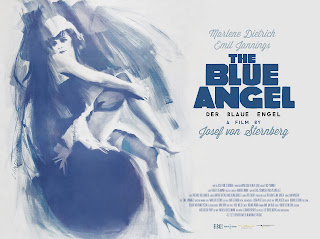Marlene Dietrich's breakthrough role as the enigmatic Lola Lola in the Weimar Cinema classic The Blue Angel is being resurrected on the big screen. Cathy Lomax looks beyond the makeup at this classic story of cruelty, desire and ruination.
The Blue Angel, directed by Josef Von Sternberg in 1930, is a cruel film. Set and made in Weimar Germany, it stars Marlene Dietrich as the insouciant seductress Lola Lola, a showgirl who makes her living singing in seedy nightclubs. Lola has become the pinup for a group of local schoolboys who furtively peek at a saucy postcard of her in class, blowing on her feathery skirt to watch it flutter and lift. Their teacher, the pompous self-absorbed Professor Rath (Emil Jannings), confiscates the card and decides to visit The Blue Angel, where Lola sings, in order to catch his students in the act of breaking school rules. However once in the club, a place that he feels strangely excited by, he stumbles backstage, becomes mesmerised by Lola and the seeds of his downfall are sown.
Dietrich’s Lola is sexy and enigmatic but she has a rough, unfinished look with fluffy hair and a distinct plumpness. She is definitely not the svelte sophisticated beauty of Shanghai Express (1932) and The Scarlet Empress (1934). However despite thisThe Blue Angel won Dietrich a Hollywood contract and under the guidance of director Von Sternberg she refined her image to perfect the glamorous and mysterious femme fatale she is best known for portraying.
Key to the dark attitude of the film is the cruel inconsistency of Lola’s affections – occasionally she seems to genuinely care for and pity Professor Rath, while at other times we suspect that she despises him. Makeup, a key material of femininity, plays a big role in Rath’s pathetic humiliation. Alone together backstage Lola passes him her mascara to hold and as she spits in it he flinches. ‘How do you like my eyes’, she says as she applies the mascara whilst looking in three small mirrors. ‘Beautiful’ he remarks after a little coaxing. ‘You know you’re not bad looking’ she says, and as he smiles bashfully she blows her powder in his face, making him cough and splutter uncontrollably. This pattern of humiliation and tenderness continues as she brushes him down cooing ‘poor baby did I hurt you.’ Much later after they are married and his money has gone he becomes a drunk hanging around the show. It is as he crudely makes himself up as a clown that we remember the sad clown who watched Lola and the Professor get together – an earlier lover we presume who has been discarded just as the Professor will himself be thrown aside. Von Sternberg uses the feminine skin of makeup - mascara, powder and clown paint - to indicate trickery, deception and ultimately emasculation.
The film is dark and desolate but like Lola it is also mesmerising and it has spawned iconic imagery that has a life far beyond the film itself. Falling in Love Again, the song Lola sings astride a chair on stage, went on to become Dietrich’s signature song and her top hat is undoubtedly the item of clothing she is most associated with. And then there is the Kit Kat Klub in Cabaret(1972) – surely a gentrified version of the Blue Angel complete with Liza playing her own version of Lola Lola.
Cathy Lomax
From 31 May 2019 The Blue Angel will be released in selected cinemas nationwide (UK and Ireland) to coincide with the centenary of the Weimar Republic and the BFI Southbank’s major two-month season Beyond Your Wildest Dreams: Weimar Cinema 1919-1933.





No comments:
Post a Comment